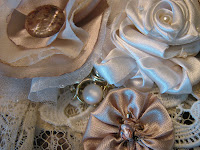

Wednesday, September 15th has been designated as "Make a Hat Day." As a theater costumer for a number of years, I made a lot of hats for a variety of productions. One of the best overall sources is Denise Dreher's book,
From the Neck Up: An Illustrated Guide to Hatmaking. Although it is no longer being published, it is still available on
Amazon, both some new copies as well as used.
In her book, Ms. Dreyer provides a glimpse into the history of hatmaking as well as a vast quantity of information on making a variety of different styles of hats through the centuries.

For my use in theater production, I especially appreciated her comments on design, which enabled me to create many different hats for the style of both the production and the wearer. Dreyer shares:
"In well designed hats the lines flow naturally into one another and lead the eye without any unexpected breaks or bends. Continuity must be maintained between all of the lines if the design is to be attractive. That is why soft, curvacious hats are usually trimmed with flowing ribbons and flowers while stiff, straight hats receive a more severe, tight hatband and flat bow.
"There are no pre-determined rules as to which lines best flatter which faces and figures. It is largely a matter of observation and experiment on the part of the designer. Through careful studies of people wearing hats, you will soon develop a good sense of this. Begin by trying several hats on yourself and note the changes."

There are a number of simple ways to make a hat if you don't want to start with a pattern. One I have used to good effect is to cover a straw hat with fabric and then add trims. The supplies you will need are:
* Designer fabric of your choice for covering the hat
* 1" wide grossgrain ribbon the measurement of the inside circumference of the crown plus 2" for overlap for making a sweat band (and for covering your raw edges of fabric from the brim cover)
* Fancy ribbon (minimum 1" wide) the measurement of the crown plus 2" for overlap for making the outer hat band (and for covering the raw edges of fabric where the brim and crown covers meet)
* Flowers, feathers and other trims to decorate the hat
* Glue (a heavy craft glue works best)
Step #1: To cover a hat, you must first take several crucial measurements:
* the diameter of the crown
* the circumference of the brim
* the depth of the brim (from where it joins the crown to the outer edge of the brim)
Step #2: To the diameter of the crown, add two inches. Then, create a circle based on that measurement. That will be your pattern for covering the crown.
Step #3: To the circumference of the brim, add one inch (for a seam allowance). That will be the length of the brim pattern. To determine the width of the brim pattern, double the depth of brim measurement you took and add two inches.
Step #4: Now, using the patterns you have made, cut one brim and one crown out of the designer fabric of your choice for covering the hat.
Step #5: One-half inch in from the edge of the crown you have cut from fabric, run a loose stitch (preferably by sewing machine) all the way around for gathering. Place the fabric crown over the crown of the hat and gather up the stitches until the crown fits smoothly. Carefully lift the edge and apply glue. Press the fabric against the straw hat crown.

Step #6: Take the brim fabric you have cut to the pattern and join the two short ends together, right sides together, sewing in a 1/2" seam. Press the seam allowance open. Then, fold the width of the fabric, wrong sides together and press all along the fold. Open back up and run a loose gathering stitch along BOTH long edges of the brim fabric (be sure you are sewing each edge separately).
Step #7: Place the brim fabric over the brim, one edge under the brim and the other edge on top of the brim (with the fold at the outermost edge of the brim). Pull the gathers up on each side, encasing the brim as you do so. Make sure the inside edge of the brim tucks just up into the crown on the inside and glue those gathers in place. The outer gathers can be covered more effectively with the fancy hatband should there be an slight gap. Glue the outer brim edge next to the crown.
Step #8: Now, using the grossgrain ribbon, cover the raw edges and gathers of the brim fabric, creating a sweatband. Fold the last bit of the ribbon before you glue it down so there are no raw edges of the ribbon.

Step #9: Using your fancy hat band ribbon, cover the gathers and raw edges on the outside of the had where the crown and brim fabrics join. Fold the last bit of the ribbon before you glue it down so there are no raw edges of the ribbon. I leave the top edge of the ribbon band open to help hide any trims or feathers I might add, gluing that down as I go.
Step #10: Trim your hat with flowers, lace, or feathers -- or all of the above! Hot glue can be effective at this point, especially if you want the placement to be "just so."
If you cannot find a suitable hat to cover, it is easy to make a hat from scratch. There are patterns available for different styles. The hat pattern I have available in my
Etsy store is very versatile. Even though it is shown with a Victorian style (perhaps appealing to the Steampunk culture or Halloween costuming), different trims would give it a more modern appeal.

Hat Pattern:


















